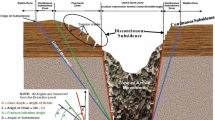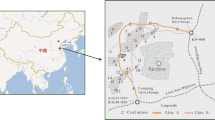Abstract
Subsidence-associated damage to surface structures like railway tracks over old mine workings instigate catastrophic impacts on human lives. The complexity of investigating old mine workings pose challenges owing to unapproachability restricting visual access, incomplete historical plans, limited record information, etc. The crux in studying unapproachable areas circumscribes the ambit of in-depth research. Thus, the framework of the investigational approach has been addressed in three segments (subsidence investigation, geophysical investigation and coal pillar stability analysis) to gather additional records to culminate the safety of the railway track located above old workings. A subsidence investigation has been conducted for a period of 9 months to assess the present status of ground movement along the railway track. Integration of geophysical investigation led to evaluating the impact of old workings on the overlying strata that can lead to subsidence in the future. Electrical resistivity tomography (ERT) technique has been used to assess the status of old underground workings, which resulted in the identification of sub-surface void as well as overlying strata disturbance status. Numerical modeling using FLAC3D, including the empirical method, has been undertaken to investigate the stability of coal pillars with respect to pillar dimensions and rock properties. The multiphase investigation resulted in arriving at a concrete understanding of the ground condition with respect to stability.
Research highlights
-
Stability of ground over old mine working was conducted by segmenting the investigation into three broad orientations i.e. by geophysical investigation to assess the ground movement status in the past, subsidence measurement for present ground status and empirical & numerical modeling for futuristic possibility of ground movement.
-
Geophysical investigation was carried out to assess the ground movement status in the past.
-
Subsidence measurement was conducted to evaluate for present ground movement status.
-
Empirical and numerical modeling was conducted to estimate futuristic possibility of ground movement along railway line.








Similar content being viewed by others
References
Anon 2002 In situ stress measurement in underground coal mines and its application to stability analysis; CMRI S&T Report.
Ansari A, Rao K S and Jain A K 2022a Damage analysis of seismic response of shallow tunnels in Jammu; In: Recent developments in sustainable infrastructure (ICRDSI-2020)—GEO-TRA-ENV-WRM, Springer, Singapore, pp. 611–619, https://doi.org/10.1007/978-981-16-7509-6_47.
Ansari A, Rao K S and Jain A K 2022b Seismic vulnerability of tunnels in Jammu and Kashmir during post-seismic functionality; Geotech. Geol. Eng. 40(11) 1–26, https://doi.org/10.1007/s10706-022-02341-0.
Ansari A, Rao K S, Jain A K and Ansari A 2022c Deep learning model for predicting tunnel damages and track serviceability under seismic environment; Model. Earth Syst. Environ. 8(4) 1–20, https://doi.org/10.1007/s40808-022-01556-7.
Ansari A, Zahoor F, Rao K S and Jain A K 2022d Seismic response and vulnerability evaluation of Jammu Region (Jammu and Kashmir); Indian Geotech. J. 52(6) 1–14, https://doi.org/10.1007/s40098-022-00694-0.
Ansari A, Rao K S and Jain A K 2023a Seismic response and fragility evaluation of circular tunnels in the Himalayan region: Implications for post-seismic performance of transportation infrastructure projects in Jammu and Kashmir; Tunn. Undergr. Space Technol. 137 1–13, https://doi.org/10.1016/j.tust.2023.105118.
Ansari A, Zaray A H, Rao K S, Jain A K, Hashmat P A, Ikram M K and Wahidi A W 2023b Reconnaissance surveys after June 2022 Khost earthquake in Afghanistan: Implication towards seismic vulnerability assessment for future design; Innov. Infrastruct. Solut. 8(3) 1–15, https://doi.org/10.1007/s41062-023-01077-x.
Banham S G and Pringle J K 2011 Geophysical and intrusive site investigations to detect an abandoned coal-mine access shaft, Apedale, Staffordshire, U.K.; Near Surf. Geophys. 9 483–496.
Butchibabu B, Khan P K and Jha P C 2021 Geophysical investigations for stability and safety mitigation of regional crude-oil pipeline near abandoned coalmines; J. Geophys. Eng. 18 145–162.
Chambers J E, Wilkinson P B, Weller A L, Meldrum P I, Ogilvy R D and Caunt S 2007 Mineshaft imaging using surface and cross-hole 3D electrical resistivity tomography: A case history from the East Pennine Coalfield, U.K; J. Appl. Geophys. 62 324–337.
Chandra D 1992 Jharia coalfield; Mineral resources of India, Geological Society of India, Bangalore, pp. 142–148.
Culshaw M, Donnelly L and McCann D 2004 Location of buried mineshafts and adits using reconnaissance geophysical methods; In: Engineering geology for infrastructure planning in Europe (eds) Hack R, Azzam R and Charlier R, Springer-Verlag, Berlin, Heidelberg.
Donnelly L J, Culshaw M G, Bell F G and Tragheim D 2006 Ground deformation caused by fault reactivation: Some examples, IAEG2006; Geol. Soc. Lond. 111 1–13.
Farooq M, Park S, Young S, Kim J, Mohammad T and Adepelumi A A 2012 Subsurface cavity detection in a karst environment using electrical resistivity (er): A case study from yongweol-ri, South Korea; Earth Sci. Res. J. 16(1) 75–82.
Huang J, Tian C, Xing L, Bian Z and Miao X 2017 Green and sustainable mining: Underground coal mine fully mechanized solid dense stowing-mining method; Sustainability 9(8) 1418.
Karfakis M G 1993 Residual subsidence over abandoned coal mine; In: Comprehensive Rock Engineering (ed.) Hudson J A, 5 451–476.
Kumar D 2012 Efficacy of electrical resistivity tomography technique in mapping shallow subsurface anomaly; J. Geol. Soc. India 80(3) 304–307.
Kushwaha A, Tewari S, Mandal P K, Bhatacharjee R, Das A J and Singh K K K 2019 Stability evaluation of old and unapproachable underground mine workings below surface structures; J. Geol. Soc. India 93 351–359.
Luo X, Gong S, Huo Z, Li H and Ding X 2019 Application of comprehensive geophysical prospecting method in the exploration of coal mined-out areas; Adv. Civ. Eng. 2019 Article ID 2368402, 17.
Pan R, Li Y, Wang H, Xu Y and Yang H 2020 Assessment of ground instability risk of lower seam longwall panels during crossing overlying remnant pillars; R. Soc. Open Sci. 7 201249.
Peng S S 1978 Coal mine ground control; John Wiley & Sons, New York, pp. 181–182.
Peng S and Zhang J 2007 Engineering geology for underground rocks; Springer, Berlin Heidelberg New York, 319p.
Peng S, Wang X, Liu X and Zhao S 2001 Experimental study of creep behaviors of the roadway in weak coal seam and rocks; J. China Coal Soc. 26(2) 149–152.
Pilecki Z, Krzysztof K, Elżbieta P, Andrzej K, Sylwia T and Tomasz L 2021 Identification of buried historical mineshaft using ground-penetrating radar; J. Eng. Geol. 294 106400.
Prakash A and Singh K B 2011 Old coal mine workings shaping to cataclysm – A study at Jharia and Raniganj coalfields; Asian J. Water Environ. Pollut. 8(3) 59–66.
Prakash A, Lokhande R D and Singh K B 2010 Impact of rainfall on residual subsidence in old coal mine workings; J. Environ. Sci. Eng. 52(1) 75–80.
Sami E, Karakus M and Nazem M 2019 Assessing the effects of rock mass gradual deterioration on the long-term stability of abandoned mine workings and the mechanisms of post-mining subsidence – A case study of Castle Fields mine; Tunn. Undergr. Space Technol. 88 169–185.
Schoor M and Fourie C J S 2014 The application of geophysics in South African coal mining and exploration; J. South Afr. Inst. Min. Metall. 114 875–879.
Sheorey P R 1987 Coal pillar strength estimation from failed and stable cases; Int. J. Rock Mech. Mining Sci. Geomech. Abs. 24(6) 347–355.
Sheorey P R 1994 A theory for in-situ stresses in isotropic and transversely isotropic rock; Int. J. Rock Mech. Mining Sci. 31 23–34.
Sheorey P R 2001 Design of pillars in underground coal mining; Course on theory and practices of ground control on bord and pillar mining, CMRI, Dhanbad, Jharkhand, India, pp. 91–115.
Strozik G, Jendruś R, Manowska A and Popczyk M 2016 Mine subsidence as a post-mining effect in the Upper Silesia Coal Basin; Pol. J. Environ. Stud. 25(2) 777–785.
Tuckwell G, Grossey T, Owen S and Stearns P 2008 The use of microgravity to detect small distributed voids and low-density ground; Q. J. Eng. Geol. Hydrogeol. 41 371–380.
Unlu T, Akcin H and Yilmaz O 2013 An integrated approach for the prediction of subsidence for coal mining basins; Eng. Geol. 166 186–203.
Vaish J and Pal S K 2015 Geological mapping of Jharia Coalfield, India using GRACE EGM2008 gravity data: A vertical derivative approach; Geocarto Int. 30 388–401.
Ward W H and Pender M J 1981 Tunnelling in soft ground – general report. Proc. of the l0th International Conference on Soil Mechanics and Foundation Engineering 4 261–275.
Acknowledgements
The authors express sincere gratitude to the Director, CSIR-Central Institute of Mining and Fuel Research, Dhanbad, for permitting them to publish the research article. Special thanks are extended to the mine management for providing all necessary facilities for the successful accomplishment of field investigation and, eventually, the research work. The views expressed in this paper are those of the authors and not necessarily of the organization they represent.
Author information
Authors and Affiliations
Contributions
Dr Amar Prakash carried out a subsidence investigation and analysis on ground movement. Dr Abhay Kumar Bharti conducted a geophysical investigation and interpretation on void detection. Dr Avinash Paul conducted a stability analysis of standing coal pillars by numerical and empirical modeling.
Corresponding author
Additional information
Communicated by Arkoprovo Biswas
Rights and permissions
About this article
Cite this article
Prakash, A., Bharti, A.K. & Paul, A. Multiphase assessment of post-mining effect on railway structures: A case study of Jharia Coalfield. J Earth Syst Sci 132, 154 (2023). https://doi.org/10.1007/s12040-023-02169-z
Received:
Revised:
Accepted:
Published:
DOI: https://doi.org/10.1007/s12040-023-02169-z




